
views
X
Expert Source
Alexander Ruiz, M.Ed.Educational Consultant
Expert Interview. 18 June 2020.
You want to make sure you address letters of recommendation correctly, so they arrive to the proper place. If you are a student, you may be required to provide addressed envelopes to your teachers after requesting letters of recommendation.
Addressing the Envelope

Find the address you need. You will need to send your letter of recommendation to the admissions office at a college. If you're a student, you often have to provide your teacher with an addressed envelope when requesting a letter of recommendation, so make sure you know the proper address. If you are a student, the address should be specified somewhere in the application instructions. You can also find the address of a college's admissions office online. However, you should call the office to double check this is the proper place to send application materials. If you are a teacher, your student should be able to provide you with this information. If your student cannot provide the information, you can also check online and call the admissions office.
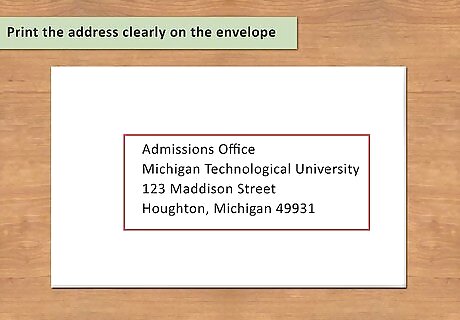
Print the address clearly on the envelope. In the middle of the envelope, you should print the address of the administration office. Make sure to print clearly so the letter is delivered to the proper place. If you have sloppy handwriting, consider making a trip to a print shop to type and print out addressed envelopes. The first line of the address should say something like, "Office of Admissions" or "Admissions Office." The second line should include which university the letter is being sent to, like "Michigan Technological University." The third line should include the address of the admissions office. For example, "123 Maddison Street." The last line should include the city, state, and zip code. For example, "Houghton, Michigan 49931." You can also use your own computer or a typewriter to print address labels for an envelope. This may be a good idea if you have sloppy handwriting.
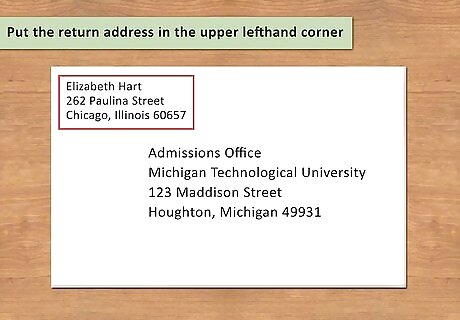
Put the return address in the upper lefthand corner. The return address is the address of the person writing the letter. If you're providing your teacher with an addressed envelope, you may need to ask for his or her personal address. However, it's usually safe to simply use your school's address. If you're filling out an application for a student, simply put your home address. The first line should just be your name, or the name of your teacher. For example, "Elizabeth Hart." The second line should include your address, or your teacher's address. For example, "262 Paulina Street." The last line should include the city, state, and zip code. For example, "Chicago, Illinois 60657."
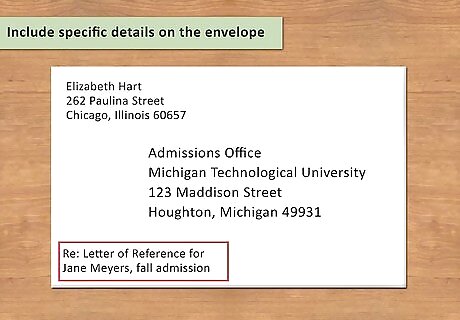
Include specific details on the envelope. In order to assure the letter smoothly gets to the right place, include details on what the recommendation is for in the lower lefthand corner. Admissions offices get letters regarding things like scholarships in addition to applications for admission, so there may be multiple branches of an admissions office. In the lower left hand corner, write "Re" followed by a colon. From there, include some specific information about what the letter is regarding. You can write something like, "Letter of Reference for Jane Meyers, fall admission." If you're applying to something like early admission, it may be a good idea to include that information as well.
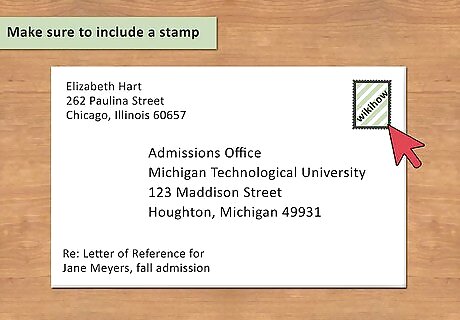
Make sure to include a stamp. All letters require proper postage if you want them to be mailed. You can buy stamps at a post office, as well as many grocery stores and drug stores. Place a stamp in the upper righthand corner of your letter. If an envelope contains materials beside a letter, you may need two stamps. If you're unsure of postage, go to a post office and ask. You want to make sure your letter is mailed successfully.
Drafting Your Salutation

Create a heading for your letter. Most letters, especially formal letters like letters of recommendation, should include a heading. If you are writing a letter of recommendation for a student, include a heading one to one and a half inches from the top of the page. On the right corner, print your full address. Words like "street" and "avenue" should be spelled out. You can abbreviate your state name, using US postal code abbreviations. In the corresponding left corner, write the date the letter is being written. Make sure to spell out the month instead of using an abbreviation.
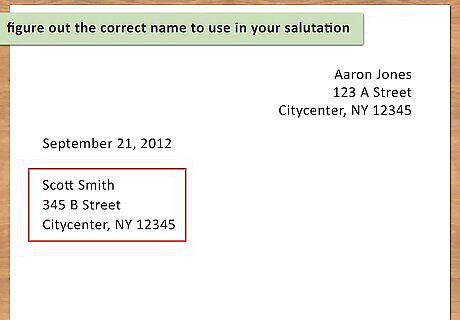
Try to figure out the correct name to use in your salutation. It's best to include a specific name in your salutation, so try to find the name of the head of admissions. Personalizing a letter always appears the most professional. Your best option is to ask the student who requested you write the letter. The school your student is applying to may have provided him or her with specific information on addressing letters of recommendation. It's always best to ask the student first before attempting to write your salutation on your own. You also may be able to find the name of the head of admissions online. However, make sure the information is up-to-date. You do not want to address the letter to someone who is no longer affiliated with a given school.
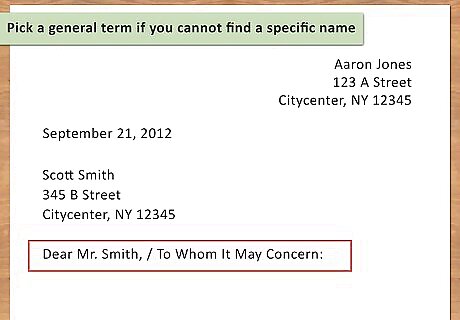
Pick a general term if you cannot find a specific name. If you are unable to locate that specific information, use a general term. For example, you could write, "Dear College Admissions Representatives." Remember, being specific is important, so it's best to avoid things like, "To Whom It May Concern."
Following Protocol for Mailing Letters

Submit references separately from the rest of your materials. In general, references should not be mailed in with your other application materials. Unless the college specifically requests all materials be sent in together, mail recommendations separately. Usually, your teacher is responsible for mailing in his or her own letters. If there is a deadline, make sure to let your teacher know so he or she mails the letter out in time.
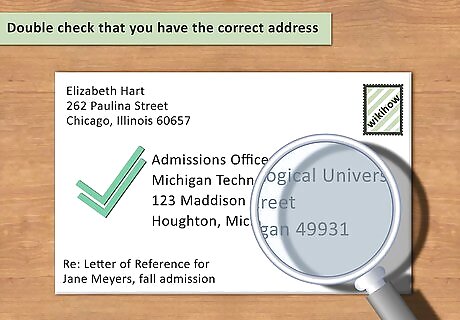
Double check that you have the correct address. You want to be certain your letter goes to the right place. Check addresses carefully when filling out envelopes. If you're applying to multiple schools, it can get confusing, so double check the address before providing your teacher with an envelope.

Do not worry about letters arriving before your application. Many students stress about letters arriving before the application has been sent in. People working at the admissions office understand materials arrive at different times, and file application materials together as they come in. As long as your letter's envelopes specifies this is an application letter for you, it will filed under your name. When the rest of your application materials arrive, they will be added to your file.

Confirm your letter has arrived. You want to make sure your letter arrives at your school, as your application may not be accepted without a letter. See if there's a way to check up on your application materials online. Many schools accept online applications, and you may get a notification when your all your letters of recommendation have arrived.










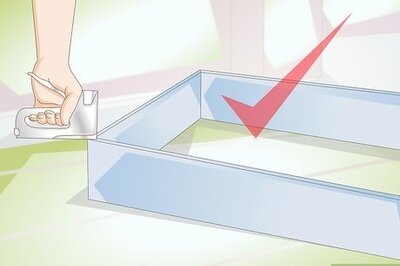


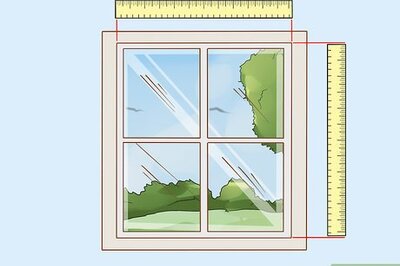




Comments
0 comment